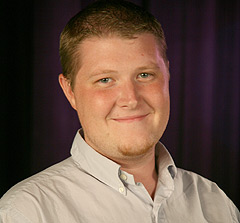Powering Up Encoding With the Digital Rapids StreamZHD Server


Why did you need to upgrade your MPEG-2 workflow?
Well, our old workflow wasn’t working! Renegade is a full-service agency, and I run the post-production side of it. We’ve got five Avid edit suites, and we just added a sixth Final Cut Pro station to deal with Red footage. But our DVD workflow wasn’t working. We had a hardware MPEG encoder card, the MediaPress X, which was fantastic. But it was one card on one local machine, so only one person could be using it. And you physically had to start the play and record process on two separate computers via a KVM switch to get it to work. But it was fine for a while, when we didn’t have a high demand for DVDs. But we eventually needed a better solution.
I talked to some friends we work with through Digital Video Group in Virginia. They recommended the [Digital Rapids] StreamZHD Box. I ran some tests, doing some live feeds of an HD spot from one of our Avids, and got fantastic encodes.
How does that box work with your existing systems?
Since it’s a standalone server, we put it in our racks and connected it to the Unity so it could see all of our footage. We kick out QuickTime reference files to a watch folder on the StreamZ and it converts [the corresponding media clips on the Unity system] to MPEG-2. All the suites are equipped with DVD Studio Pro, so we can bring the files in [to the 4 TB NAS], author our discs, and send them to an R-Quest robotic DVD duplicator. Now anyone can do it. It’s all automated.
How much can you actually automate the DVD-creation process?
We can do simple automation with a script. You create the MPEG-2 and specify a play-only disc and send it to the R-Quest [duplicator]. We can’t do automation of a printed disc. After it burns the disc, we still have to tell it what print file to use. It has to be a two-step process. But if we had a Rimage duplicator, it could kick out a printed disc. That’s the next upgrade we’ll do. But a lot of stuff we’re doing isn’t a play-only disc, so we have to author it anyway. We’ll use the StreamZ to do the MPEGs, and then we’ll author discs that go out for consumer purchases, some documentaries, and things like that.
What about MPEG-4 and other advanced codecs?
The StreamZHD does pretty much everything. We currently use it to do WMVs for Web posting. We have the On2 Flix Pro [software] converter for Flash video, but we do some of our Flash conversions on the StreamZHD. We’ve had the StreamZHD do H.264 QuickTimes for airing. We also do digital delivery through DGFastchannel using the StreamZHD for both SD and HD delivery to stations. All of the digital delivery is automated. I just set up the watch folder, compression settings and FTP address. It converts it and throws it up to Fastchannel’s FTP and sends me an email saying the transfer was successful or failed.
Do clients ever request Blu-ray Discs?
We’ve only had to deliver Blu-ray to one client. We could put in Blu-ray drives, but the demand isn’t there right now. Anything else that has gone out of here in HD to stations has been digital delivery or as a QuickTime file on a data DVD. We do use a lot of Blu-rays for our archive, just because they can hold so much. But most of the people I interact with don’t have Blu-ray players.
What do you still need to improve in your workflow?
We need to get the Transcode Manager server and software from Digital Rapids. The only issue with the StreamZHD is that it can only have one watch folder at a time. We have it set up for MPEG-2, and whenever we need to do digital delivery, I remote into the server and switch the watch folder. With Transcode Manager, we can have multiple watch folders and multiple encodes at the same time, and that’s something we want.
Sections: Creativity Technology
Topics: Feature Project/Case study
Did you enjoy this article? Sign up to receive the StudioDaily Fix eletter containing the latest stories, including news, videos, interviews, reviews and more.